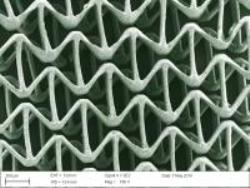A team of Nanoengineers at the University of California have made a groundbreaking invention of a biomaterial that is similar to human tissue. Due to the similarity to human tissue, the new material is suitable for repairing damaged human tissue. Shaochen Chen, a professor in the Nanoengineering department, is positive that artificially created tissues such as this would show more compatibility with the natural tissues.
 A new biomaterial designed for repairing damaged human tissue doesn’t wrinkle up when it is stretched. The invention from nanoengineers at the University of California, San Diego marks a significant.
A new biomaterial designed for repairing damaged human tissue doesn’t wrinkle up when it is stretched. The invention from nanoengineers at the University of California, San Diego marks a significant.
The new material was designed by utilizing the biofabrication technique developed by Chen. The technique uses a computer based projection system and lightweight mirrors that can be controlled with high precision. Using this system, Chen was able to build 3D scaffolds that had well-defined patterns. This system can be adopted to produce various types of materials such as metal components, which can be used in spacecraft and ships as well.
The shape of the tissue was the most important aspect of the mechanical property of the material. The research team has come up with two new shapes called “cut missing rib” and “re-entrant honeycomb”. Both shapes show negative Poisson’s ratio property whether the tissue patch is present in single or multiple layers. The thickness of the artificial tissue is decoded based on the thickness of the natural tissue that is being repaired.
The team is looking at the next phase of the research work where they would jointly work with the Bioengineering wing of Jacobs School of Engineering to create tissue grafts that would help repair damaged blood vessels.